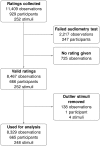Groove in drum patterns as a function of both rhythmic properties and listeners' attitudes
- PMID: 29958289
- PMCID: PMC6025871
- DOI: 10.1371/journal.pone.0199604
Groove in drum patterns as a function of both rhythmic properties and listeners' attitudes
Abstract
Music psychology defines groove as humans' pleasureable urge to move their body in synchrony with music. Past research has found that rhythmic syncopation, event density, beat salience, and rhythmic variability are positively associated with groove. This exploratory study investigates the groove effect of 248 reconstructed drum patterns from different popular music styles (pop, rock, funk, heavy metal, rock'n'roll, hip hop, soul, R&B). It aims at identifying factors that might be relevant for groove and worth investigating in a controlled setting in the future. Drum patterns of eight bars duration, chosen from 248 popular music tracks, have been transcribed and audio reconstructions have been created on the basis of sound samples. During an online listening experiment, 665 participants rated the reconstructions a total of 8,329 times using a groove questionnaire. Results show that, among 15 tested variables, syncopation (R2 = 0.010) and event density (R2 = 0.011) were positively associated with the groove ratings. These effects were stronger in participants who were music professionals, compared to amateur musicians or mere listeners. A categorisation of the stimuli according to structural aspects was also associated with groove (R2 = 0.018). Beat salience, residual microtiming and rhythmic variability showed no effect on the groove ratings. Participants' familiarity with a drum pattern had a positive influence on the groove ratings (η2 = 0.051). The largest isolated effect was measured for participants' style bias (R2 = 0.123): groove ratings tended to be high if participants had the impression that the drum pattern belonged to a style they liked. Combined, the effects of style bias and familiarity (R2 = 0.152) exceeded the other effects as predictors for groove by a wide margin. We conclude that listeners' taste, musical biographies and expertise have a strong effect on their groove experience. This motivates groove research not to focus on the music alone, but to take the listeners into account as well.
Conflict of interest statement
The authors have declared that no competing interests exist.
Figures






References
-
- Madison G. Different kinds of groove in jazz and dance music as indicated by listeners’ ratings. In: Proceedings of the VII International Symposium on Systematic and Comparative Musicology III International Conference on Cognitive Musicology. Jyväskylä: Department of Musicology, University of Jyväskylä; 2001. p. 108–112.
-
- Madison G. Experiencing Groove Induced by Music: Consistency and Phenomenology. Music Perception: An Interdisciplinary Journal. 2006;24(2):201–208. doi: 10.1525/mp.2006.24.2.201 - DOI
-
- Madison G, Gouyon F, Ullén F, Hörnström K. Modeling the tendency for music to induce movement in humans: first correlations with low-level audio descriptors across music genres. Journal of Experimental Psychology Human Perception and Performance. 2011;37(5):1578–1594. doi: 10.1037/a0024323 - DOI - PubMed
-
- Janata P, Tomic ST, Haberman JM. Sensorimotor coupling in music and the psychology of the groove. Journal of Experimental Psychology General. 2012;141(1):54–75. doi: 10.1037/a0024208 - DOI - PubMed
-
- Witek MAG, Clarke EF, Wallentin M, Kringelbach ML, Vuust P. Syncopation, Body-Movement and Pleasure in Groove Music. PLoS ONE. 2014;9(4). doi: 10.1371/journal.pone.0094446 - DOI - PMC - PubMed
Publication types
MeSH terms
LinkOut - more resources
Full Text Sources
Other Literature Sources
Miscellaneous

